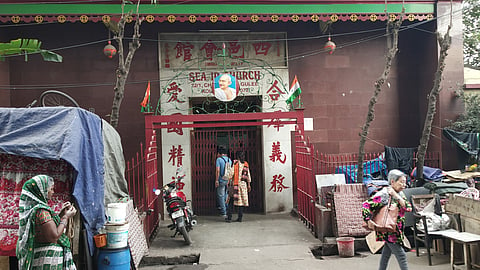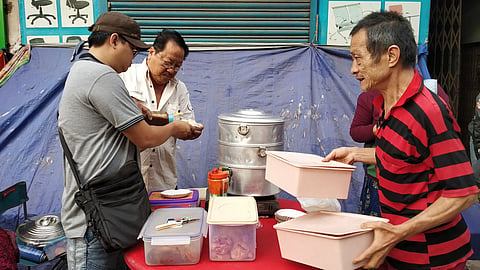It was a mellow February morning and we were gathered at the famous Sunday morning Chinese Breakfast Market located in central Kolkata. There was no lack of enthusiasm as resident Kolkatans as well as visitors from abroad wandered about, sampling the freshly prepared soups and dumplings, baos and suimais, etc. But what most did not realise is that the number of Chinese stalls has sharply declined over the past decade. And those still operating are mostly run by senior citizens who set up these stalls more by way of habit than for monetary gains. The market seemed to present in a nutshell the bleak future of the once flourishing Chinese community who had called Kolkata home.
A Walk Through Kolkata’s Cheenapara
Take a walk through India’s oldest Chinatown before this chapter of urban history draws to a close
According to records, Atchew or Tong Achew was the first Chinese to settle down in Calcutta (as Kolkata was then known as) in the late 18th century. An entry in the Bengal District Gazetteers: 24 Parganas says Tong Achew was given a grant of land by East India Company’s Governor General Warren Hastings where he set up a sugar manufacturing plant. Even though the sugar mill closed down after the death of Atchew, many of the Chinese workers moved to Kolkata and were later joined by others from the homeland. Although the genesis of the Chinatown in the Tiretta Bazar (or Teriti Bazar) area of central Kolkata is a bit of a puzzle, it is believed that people from the Haka community were among the first ones to arrive. They were later joined by the Cantonese, the Hupey and the Shanghai group. Soon these people excelled in various trades and professions, including leather tanning and manufacturing, dentistry, restaurants, beauty parlours etc. Much later, as the tanneries and leather manufacturing units moved to the eastern fringe of the city and a part of the Chinese community moved there, Kolkata got its second Chinatown in the Tangra area.

Although there are many guided walks that cover Kolkata’s old Chinatown, our walk that Sunday was a special one. Organised by The Community Art Project (TCAP) as part of Sahapedia’s month-long India Heritage Walk Festival (IHWF), the walk was led by the Chinese residents of the locality, something which never happened before.
“It is the memory and identity of the Indian Chinese community in Calcutta that we aim to revive at the historic public space of Tiretta Bazaar,” said Swati Mishra, founder, TCAP, as we fell in step behind our tour leader of the day, Thomas Chen. This 40-something resident of Chinatown is one of the rare members of the community who did not leave the city for greener pastures.
Starting from the breakfast market, we entered the Chhatawala Gully, one of the narrow lanes that are a characteristic of the area. Waiting for us here was Tiencheng Huang who took us to the top of what was once one of the best looking buildings here, the Chang Lou. This building with a long façade was once home to many Chinese families but now only a few live here. Standing on the terrace overlooking the market below, Mr Huang told us about the old rites and rituals that the Chinese communities would follow, including communicating with the departed souls through mediums.
Our next stop was a shoe manufacturing unit owned by a Chinese family. We were surprised to find that each pair of shoes is still hand made. With not many Chinese labours to go around, the job is done by labours from north India. Interestingly many well-known brands source their shoes from here and add their labels to the finished products. From the shoe factory, past the popular Tung Nam Eating House, we reached Sea Ip Church. Towered by government buildings and with a garbage pickers’ colony as its immediate neighbours, the red double-storeyed building was a shadow of its bright past. As we entered the building, smell of incense wafted down, a relief from the stench outside. On the ground floor of the 1905 building was a Chinese club room while a flight of wooden stairs led us to the shrine of Kwan Yin, the goddess of war, mercy and love. The significance of the deities were explained to us. We passed the old Toong On Church and we could only imagine the famous Nanking Restaurant that once flourished here. Apparently, the city’s first Chinese eating house, it drew many famous people to it.

All that walking around had made us hungry. So we decided to stop at the D’Ley Restaurant. Soon steaming bowls of soup with dumplings and plates of baos were placed in front of us. Ms Lily, whose family has been running this eating house for generations, fussed around us like a mother hen, coaxing us to have more helpings.
After visits to some of the other temples and a noodle-making factory, we reached the Nam Soon Church. Built in 1820, this is said to be the oldest of the six Chinese temples found here. The leafy courtyard of the temple was a welcome break as it was steadily getting warmer. And little did we know about the pleasant surprise that was in store for us. As we loitered in the shade, Thomas Chen and members of TCAP broke into a song. Penned by Chen himself, the song titled ‘Cheenapara – the Breakfast Market Song’ talks about the neighbourhood, the food and the people who make Cheenapara come alive. Like a ray of hope, the lyrics lifted us from the mood of despondency that had befallen us after the walk.
It is one chapter of its urban history that Kolkata will hate to lose but the end seems inevitable if drastic measures are not taken immediately.
Information
The Chinatown in central Kolkata is very different from other Chinatowns seen across the globe. It has merged with the overall urban landscape, surviving in pockets, living in the shadow of other communities. You can take the metro railway to the Central Station, walk to the Tiretta Bazar/Poddar Court area and start exploring. Usually, the Chinese allow everyone to enter the temples. Still, it is advisable to ask for permission. The Sunday Breakfast Market usually starts at 5am and is over by 8am. A word of caution: You have to be rather strong-hearted to walk through the area, which is over run by ragpickers’ colonies, piles of garbage and roadside butcher shops.